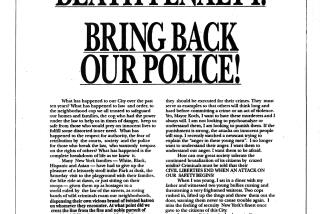But Black Lawmaker Says Jurist Created Own Problems : Racism Charged in Trial of U.S. Judge
- Share via
WASHINGTON — It was the federal judge who was on trial, and his supporters in the audience were decked out in T-shirts reading, “Not Guilty, So Says We All.”
Controversial New York minister Al Sharpton showed up before a waiting bank of cameras and denounced the proceedings as “an outrageous racist maneuver.”
Nation of Islam leader Louis Farrakhan came to town and staged a rally for the defendant, charging that whites were gunning for black leaders.
At the center of the storm, Alcee L. Hastings, the dapper first black federal judge in Florida, called his impeachment trial in the Senate a “legal lynching.”
In a spacious, wood-paneled room in the Senate’s Hart Office Building, the complicated and colorful events leading to the 14th impeachment trial in congressional history unfolded in plodding and minute detail in August.
Hastings, painting himself as a victim of overzealous prosecutors, has added the charge of racism to the already volatile mix of legal challenges and questions over the basic fairness of rehashing a case that has been decided by a jury.
In 1983, a Florida jury found Hastings not guilty of negotiating a bribe in return for going easy on a case. But a subsequent investigation by fellow judges found that Hastings had lied during the trial, and a House investigation later added charges of faking evidence and leaking information about a federal investigation.
“If I were a white person, this would not be happening to me,” Hastings has said.
However, a leading black House member dealt the charge of racism a sharp blow last year. Rep. John Conyers Jr. (D-Mich.), who was the chairman of the House impeachment subcommittee, has said that he began the proceedings with the feeling that racism might have been involved but ended up believing that “the problems created here were created by Judge Hastings himself.”
Another complication is that the evidence against Hastings is entirely circumstantial, and its interpretation rests on two opposing portraits of the judge.
One, painted by Hastings, is of a humane, liberal black judge--”touched by greatness,” in his lawyer’s words--who has become the unwitting participant in a Kafkaesque nightmare, a lone figure buffeted by forces beyond his control.
The other picture, sketched by the prosecution, is of a greedy, conniving operator who, when caught with his hand in the cookie jar, did not have the good grace to spare his office taint by resigning and whose efforts to clear his name have only added to his problems.
Senators defended the impeachment proceedings by saying that the standard for judicial conduct is higher than avoiding a felony conviction. The Supreme Court, rebuffing Hastings’ charge that impeachment constitutes double jeopardy, refused to review a lower court’s ruling against the judge.
“It’s been very difficult for me to go through all this for eight years,” Hastings said at this summer’s hearings. “I don’t know what the hell is going on here. I really don’t.”
The last act of the drama will be played out at the end of the month, when the full Senate, meeting in closed session, gives both sides their final hearing and votes whether to unseat Hastings.
More to Read
Sign up for Essential California
The most important California stories and recommendations in your inbox every morning.
You may occasionally receive promotional content from the Los Angeles Times.













